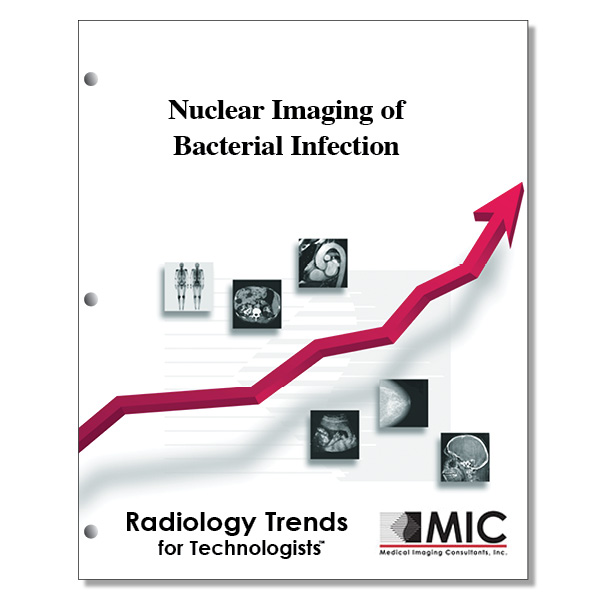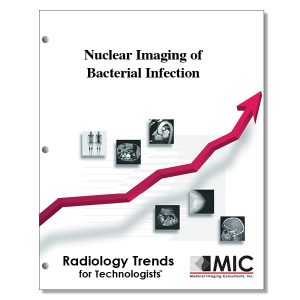

Nuclear Imaging of Bacterial Infection
A review of current imaging techniques for bacterial infection diagnosis, and a preview of novel radiotracers currently in development.
Course ID: Q00659 Category: Radiology Trends for Technologists Modalities: CT, MRI, Nuclear Medicine, PET, Sonography1.75 |
Satisfaction Guarantee |
$24.00
- Targeted CE
- Outline
- Objectives
Targeted CE per ARRT’s Discipline, Category, and Subcategory classification:
[Note: Discipline-specific Targeted CE credits may be less than the total Category A credits approved for this course.]
Computed Tomography: 0.50
Procedures: 0.50
Head, Spine, and Musculoskeletal: 0.25
Neck and Chest: 0.25
Magnetic Resonance Imaging: 0.50
Procedures: 0.50
Neurological: 0.25
Musculoskeletal: 0.25
Nuclear Medicine Technology: 1.25
Procedures: 1.25
Other Imaging Procedures: 1.25
Radiography: 0.50
Procedures: 0.50
Head, Spine and Pelvis Procedures: 0.25
Thorax and Abdomen Procedures: 0.25
Registered Radiologist Assistant: 1.00
Procedures: 1.00
Abdominal Section: 0.25
Thoracic Section: 0.25
Musculoskeletal and Endocrine Sections: 0.25
Neurological, Vascular, and Lymphatic Sections: 0.25
Sonography: 0.50
Procedures: 0.50
Abdomen: 0.25
Superficial Structures and Other Sonographic Procedures: 0.25
Outline
- Introduction
- Imaging Infection: The State of the Art
- Structural Imaging Techniques
- Functional Imaging Techniques
- Clinical Uses of NM in Imaging Infection
- Musculoskeletal Infection–Osteomyelitis
- Cardiovascular System Infection
- FUO
- Newer Approaches to Microorganism-Specific Imaging
- Antibiotics
- Carbohydrates
- Cofactor or DNA Synthesis
- Iron Transport and Storage
- D-Amino Acids
- Conclusion
Objectives
Upon completion of this course, students will:
- know the patient population(s) for which diagnosing infections can be difficult due to infectious and inflammatory conditions having similar signs and symptoms
- understand where structural imaging techniques excel in infection diagnosis
- be familiar with the strengths of the various medical imaging methods that are used to diagnose infection
- know the most commonly used noninvasive technique for tissue structure evaluation
- understand the advantages and disadvantages of MR structural imaging
- know what is anticipated by the clinicians using NM techniques for infectious disease evaluation
- know what the uptake of radiolabeled diphosphonate in pathologic processes depends upon in bone scintigraphy
- know the phases of a TPBS and what they demonstrate
- be familiar with the facts of scintigraphy with labeled autologous white blood cells
- be familiar with the administered activity range in MBq for the various NM imaging techniques
- know what can be done to possibly improve WBC scintigraphy’s specificity
- understand the advantage of 67Ga-citrate imaging over WBC scintigraphy for immune-compromised patients
- be familiar with the patient preparation requirements for 18F-FDG imaging
- understand the reasons why the diagnosis of osteomyelitis commonly delayed
- know the test of choice for the assessment of peripheral bone infections in patients who have undergone intervention
- be familiar with the strengths and weaknesses of the various NM imaging techniques for spinal osteomyelitis
- be familiar with the NM imaging options for the assessment for possible prosthetic joint infection in both early and late stages post-surgery
- know how NM imaging can best contribute to the diagnosis of cardiovascular system infections
- know what has been suggested by a recent metaanalysis about 67Ga-citrate imaging for FUO
- be familiar with the targeted unique microbial pathways used by some of the newer radiotracer methods for bacterial infection evaluation
- be familiar with the mechanisms, targeted bacterial pathogen, and the pathogens tested in vivo for recently developed bacteria-specific radiotracers
- know the reported capabilities of 18F-FPTMP in rodent models
- be familiar with how 2-deoxy-2-18F-fluoro-D-glucose-6-phosphate is made and its clinical utility
- be familiar with the various radiotracer options for targeting the maltodextrin transporter in the assessment for bacterial infections
- be familiar with the creation and use of 2-deoxy-2-18F-fluorosorbitol
- understand how radiolabeled PABA incorporates in the body for imaging
- know the method that has been shown to greatly increase the 18F-PABA uptake
- understand the demonstrated downsides found with 124I-FIAU imaging
- be familiar with some of the basic information on 68Ga citrate and its use
- be familiar with how D-amino acids can be use in the imaging process
